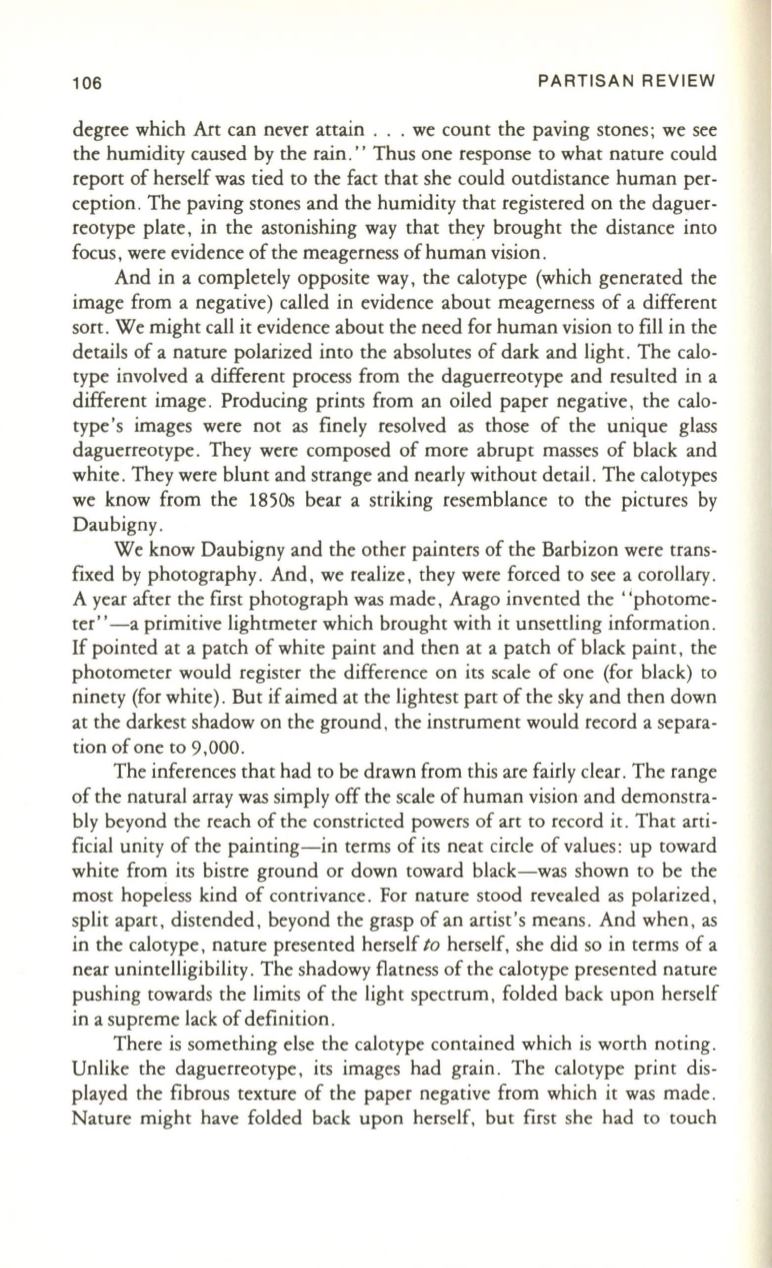
106
PARTISAN REVIEW
degree which Art can never attain ... we count the paving stones; we see
the humidity caused by the rain ." Thus one response to what nature could
report of herself was tied to the fact that she could outdistance human per–
ception . The paving stones and the humidity that registered on the daguer–
reotype plate, in the astonishing way that they brought the distance into
focus, were evidence of the meagerness of human vision.
And in a completely opposite way, the calotype (which generated the
image from a negative) called in evidence about meagerness of a different
sort . We might call it evidence about the need for human vision to fill in the
details of a nature polarized into the absolutes of dark and light . The calo–
type involved a different process from the daguerreotype and resulted in a
different image. Producing prints from an oiled paper negative, the calo–
type's images were not as finely resolved as those of the unique glass
daguerreotype . They were composed of more abrupt masses of black and
white. They were blunt and strange and nearly without detail. The calotypes
we know from the 1850s bear a striking resemblance to the pictures by
Daubigny .
We know Daubigny and the other painters of the Barbizon were trans–
fixed by photography. And, we realize, they were forced to see a corollary.
A year after the first photograph was made, Arago invented the "photome–
ter" -a primitive lightmeter which brought with it unsettling information .
If pointed at a patch of white paint and then at a patch of black paint, the
photometer would register the difference on its scale of one (for black) to
ninety (for white) . But
if
aimed at the lightest part of the sky and then down
at the darkest shadow on the ground , the instrument would record a separa–
tion of one to 9,000.
The inferences that had to be drawn from this are fairly clear . The range
of the natural array was simply off the scale of human vision and demonstra–
bly beyond the reach of the constricted powers of art to record it. That arti–
ficial unity of the painting-in terms of its neat circle of values: up toward
white from its bistre ground or down toward black-was shown to be the
most hopeiess kind of contrivance . For nature stood revealed as polarized,
split apart, distended, beyond the grasp of an artist's means. And when, as
in the calotype, nature presented herself
to
herself, she did so in terms of a
near unintelligibility. The shadowy flatness of the calotype presented nature
pushing towards the limits of the light spectrum, folded back upon herself
in a supreme lack of definition .
There is something else the calotype contained which is worth noting.
Unlike the daguerreotype, its images had grain . The calotype print dis–
played the fibrous texture of the paper negative from which it was made .
Nature might have folded back upon herself, but first she had to touch


